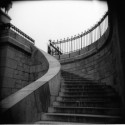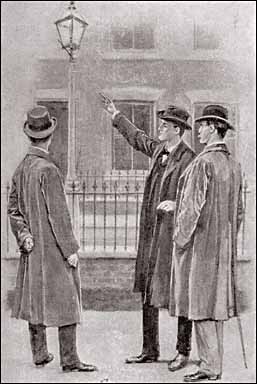A Scion Society of The Baker Street Irregulars

The 17 Steps: The Six Napoleons
Seventeen thoughts for further ponderance of the case at hand – The Six Napoleons

A FRIEND ENJOYING THE COMFORTS OF 221B
There’s something special about the beginning of this tale, a feeling that the friendly association of Holmes and Watson was not something they restricted to their own circle of two. We begin this visit to 221B with the words:
“It was no very unusual thing for Mr. Lestrade, of Scotland Yard, to look in upon us of an evening, and his visits were welcome to Sherlock Holmes . . . On this particular evening, Lestrade had spoken of the weather and the newspapers. Then he had fallen silent, puffing thoughtfully at his cigar.”
The fact that Lestrade was welcome enough at 221B to sit around and chit-chat says a lot for his relationship with Holmes. But when we first met Lestrade back in “A Study in Scarlet,” he and Inspector Gregson were rivals and seeming equals in the investigation. What was it about Gregson that he never became as friendly with Holmes as Lestrade did? Why does Holmes get along with Lestrade so well?
SHERLOCK HOLMES — HIS LIMITS: EVER CHANGING
“That’s no business of mine,” Holmes says when Lestrade first speaks of anti-Napoleon madness.
“Exactly. That’s what I said. But then, when the man commits burglary in order to break images which are not his own, that brings it away from the doctor and on to the policeman.”
“Burglary! This is more interesting.”
What happened to the Holmes of the 1880s who remarked upon how many of his cases were without any crime whatsoever? Wouldn’t finding the cause of a man breaking Napoleon busts intrigue Holmes as much as a man breaking into a house? Or was this just a pose he put on for Lestrade, who had perhaps spoken a bit *too* much of the weather and the newspapers?
THE SUCCESSFUL DOCTOR BRANCHES OUT
Dr. Barnicot, we are told, “has one of the largest practices upon the south side of the Thames. His residence and principal consulting-room is at Kennington Road, but he has a branch surgery and dispensary at Lower Brixton Road, two miles away.”
Apparently, Dr. Barnicot’s branch surgery was for the convenience of patients nearer Lower Brixton Road than his Kennington Road consulting room. But was this just another office for his use only, or would he have had some staff working there full time? Would a doctor’s large practice be of a size that he would use other, junior doctors to help him maintain it, even though it would still be considered “his” practice?
THE CANONICAL PROTOTYPE FOR A SHERLOCKIAN
“This Dr. Barnicot is an enthusiastic admirer of Napoleon, and his house is full of books, pictures, and relics of the French Emperor.”
Barnicot’s house sounds like many a Sherlockian’s house, with Napoleon filling in for Holmes. (Ironically, both men are now known to the general public as much for their hats as anything else.) But wasn’t it odd for an Englishman to have such high esteem for the French emperor? Wouldn’t this be a bit like having a Hitler collection?
THE HOUNDS FINALLY GET DIAGNOSED
Watson remarks, “There are no limits to the possibilities of monomania. There is the condition which the modern French psychologists have called the ‘idee fixe,’ which may be trifling in character, and accompanied by complete sanity in every other way.”
Complete sanity in every other way? Couldn’t Dr. Barnicot be considered a monomaniac by such a definition? And what of people with a fixation on Sherlock Holmes who are completely sane in every other way?
Was “idee fixe” a legitimate mental disorder of the time, and what were the symptoms of a typical case? Were its sufferers truly sane in every other way, leading otherwise normal lives?
TIME TO HAUL OUT THE BUTTER AGAIN
“The affair seems absurdly trifling, and yet I dare call nothing trivial when I reflect that some of my most classic cases have had the least promising commencement. You will remember, Watson, how the dreadful business of the Abernetty family was first brought to my notice by the depth which the parsley had sunk into the butter upon a hot day.”
The parsley/butter problem has been long discussed and researched by Sherlockians, and done to death on this list a few times as well. But aside from the dinner table clue, why would Watson have never written up a case that Holmes considered one of his “most classic”? How dreadful was the business of the Abernetty family if it only got noticed because the parsley was sinking into the butter? (Just play along for the moment, and pretend that parsley sinks into butter.)
THE BREAKFAST OF CHAMPIONS
Watson apparently dresses before breakfast, as Holmes tells him, “There’s coffee on the table, Watson, and I have a cab at the door.” But coffee seems to be the only breakfast Watson will be getting. In an arrangement like the one Holmes and Watson had with Mrs. Hudson, was she expected prepare (or have the cook prepare) breakfast for them every day, or just as requested? At what point might Mrs. Hudson’s preparations have been at as Holmes and Watson go racing out the door in this case?
THE CORPSE AT HARKER’S HOUSE
There are a few odd points about the man found murdered at Horace Harker’s Pitt Street home. First, Harker heard a horrible scream, apparently the dying cry, of a man whose throat was cut. Wouldn’t the “great gash” in his neck limit his vocalizing abilities? Might it have been his attacker screaming? And we are told that he lay on his back with his knees drawn up …isn’t that a little bit odd position for a man who apparently died of blood loss? Wouldn’t his legs relax and extend a bit as he died?
THE MANY THEORIES OF MORSE HUDSON
No doubt the picture and statuary business was quite dull, since Morse Hudson turns to Nihilists, anarchists, and “red republicans” just to explain the destruction of one fifteen-shilling bust. (After he was probably the original person to report capital “H” Hooliganism, as well.) Is there any logical basis for Morse Hudson’s ravings? Would any of these groups have a reason for busting Napoleon’s head in, while leaving the rest of the shop untouched?
PASSING THROUGH LONDON’S MANY FACES
“In rapid succession we passed through the fringe of fashionable London, hotel London, theatrical London, literary London, commercial London, and, finally, maritime London, till we came to a riverside city of a hundred thousand souls, where the tenement houses swelter and reek with the outcasts of Europe.”
Did each of these districts (described by Watson as one would describe a Barbie doll) have a name? Were Holmes and Watson travelling a straight path from Kensnington Road to Stepney?
PRIVACY ISSUES OF THE VICTORIAN ERA
The manager at Harding Brothers is a very helpful fellow: “Yes, we have the entries here. One to Mr. Harker you see, and one to Mr. Josiah Brown, of Laburnum Lodge, Laburnum Vale, Chiswick, and one to Mr. Sandeford, of Lower Grove Road, Reading.”
Was it necessary to give your name and address to a shopkeeper when you just want to buy a plaster bust for a few shillings? Why did the shopkeeper need it? A wholesaler keeping records of his regular customers makes some sense, but a shopkeeper dealing in fairly inexpensive knick-knacks? At what price level did one not worry about such details?
IT’S ALWAYS POLITICS, ISN’T IT?
“His name is Pietro Venucci, from Naples, and he is one of the greatest cut-throats in London. He is connected with the Mafia, which, as you know, is a secret political society, enforcing its decrees by murder.”
Was the Mafia ever anything but a criminal society? Even when associated with the government, it’s goals were never political, were they? Lestrade showing his ignorance of foreign crime with the above statement, or a deeper understanding than most?
THE LUMBER-ROOM OF HIS LUMBER-ROOM
“Holmes spent the evening in rummaging among the files of the old daily papers with which one of our lumber-rooms was packed.”
First, the simple question: where in 221 Baker Street were the lumber-rooms? Second, how could Holmes possible endeavor to keep files of all London’s daily papers? Wasn’t he cutting out bits for his scrapbook in any case, leaving most of them in not-exactly-archival shape?
JOSIAH BROWN, THE POLICEMAN’S FRIEND
Holmes, Watson, and Lestrade catch a murderer on the grounds of Josiah Brown’s house. They’ve barely got him in cuffs when Brown comes outside and jovially says, “Well, I’m very glad to see that you have got the rascal. I hope, gentlemen, that you will come in and have some refreshment.”
Seems a bit odd behaviour as the three men are still holding the murderer. Wouldn’t Brown want him out of there as quickly as possible? Would Brown have been so friendly to the neighborhood beat cop? Or is Josiah Brown a fan of The Strand Magazine who’s seizing the opportunity to get the celebrated Sherlock Holmes in his house for drinks?
COULD BEPPO BE THE MOST UNLUCKY MAN ALIVE?
First, he’s born with a monkey face. Second, he manages to kill a man with a photograph of him in his pocket. And third, and worst of all, with five out of six chances at finding the Borgia pearl in the busts he smashed, he still comes up empty! Was there anything he could have done to improve his odds, or was God just against this guy from square one?
SHERLOCK HOLMES DAY AT SCOTLAND YARD
“We’re not jealous of you at Scotland Yard. No, sir, we are very proud of you, and if you come down to-morrow, there’s not a man, from the oldest inspector to the youngest constable, who wouldn’t be glad to shake you by the hand.”
Did Lestrade mean that as a sincere invitation? Was it Holmes’s fame in The Strand that had the Yard proud of him, or the Borgia pearl case, which most of them hadn’t heard of yet? Did Lestrade expect Holmes to bring the pearl with him? (And a postscript: this one puzzled me enough that I couldn’t stop thinking about it until I found my own answer, which is coming in Monday’s Chronology Corner.)
AND WAITING ON THE BACK-BURNER …
“”Put the pearl in the safe, Watson,” Holmes instructs, when it’s all done, “and get out the papers of the Conk-Singleton forgery case.”
Was the Conk-Singleton case still going on, but so uninteresting that Holmes left it alone to pursue the pearl? Or was Holmes just going to clean up the documentation on the case, with Watson’s help? What papers was Watson responsible for regarding the cases?

The Seventeen Steps originally appeared on the Hounds of the Internet e-list from September 2000 to October 2001 and later on the Sherlock Peoria blog.
Brad Keefauver, the 41st Garrideb, is the author of The Elementary Methods of Sherlock Holmes, Sherlock and the Ladies, and The Armchair Baskerville Tour. Former publisher of The Holmes & Watson Report, The Dangling Prussian, and a whole lot of obscure, collectable little things on our boy Sherlock. Keefauver is a member of the Baker Street Irregulars and the Adventuresses of Sherlock Holmes.

Sorry, comments are closed for this post.